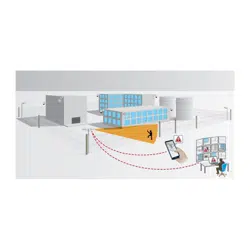Loading ...
Loading ...
Loading ...

AXIS Perimeter Defender
Get started
Advanced mitigation - You can use Headlinghts/vehicles in scene if the scene contains vehicles, headlights, or headlight effects
such as reections. Note that if you use this setting, performance can sometimes be reduced in normal conditions. By default, all
scenarios are supposed to contain vehicles and thus headlights. You can use Insects/droplets on lens to ignore triggers from
rain drops or insects, and reduce false alarms.
Sensitivity - To increase the sensitivity of the system, move the slider to the right. A higher sensitivity reduces the risk of missed
detections, but increases the risk of false alarms.
Duration parameters
For each scenario you create, you can set duration parameters.
Min presence in zone - Set the time that an object has to stay in a zone for the zone to be activated.
Narrow zone - If the zone is narrow and can be crossed in 1–2 seconds, there is a risk of missed alarms. You can mitigate this with
the Narrow zone functionality. Note that it can’t be combined with Min presence in zone.
Set up the intrusion/loitering scenario
The intrusion/loitering scenario is designed to trigger an alarm when an object enters a certain zone and remains in the zone
for longer than the predened time.
The default scenario created in the calibration step is of the type intrusion/loitering, and it uses the maximum detection zone. To
use this scenario as it is, click Accept in the Scenarios tab.
To change the default scenario:
1. Go to Scenarios > Advanced scenarios.
2. Change the default detection zone:
- To move existing points in the detection zone, click and drag them with the mouse.
- To create additional points, click any of the existing segments and drag with the mouse.
3. Under Detect, select what type of objects to detect.
4. Under Duration parameters, if you don’t want an object to trigger an alarm as soon as it enters the zone, set the loitering
time in Min presence in zone.
5. If the zone is narrow and can be crossed in 1–2 seconds, and you still want alarms to trigger, select Narrow zone. This
setting can’t be combined with Min presence in zone. For more information, see Duration parameters on page 26.
6. To upload the changes to the camera and switch back to the main view, click Accept.
Set up the zone-crossing scenario
The zone-crossing scenario is designed to trigger an alarm when an object passes through two detection zones in a given sequence.
Important
The zone-crossing scenario has the following limitation: if the object that triggers the scenario stops moving for a few
seconds in the origin zone before moving on to the end zone, the scenario doesn’t trigger.
Under Duration parameters, you can dene a minimum presence time for each of the zones in the scenario. If T
A
is the minimum
time in the origin zone and T
B
in the end zone, an alarm only triggers if the object stays longer than T
A
in the origin zone and
then longer than T
B
in the end zone.
1. Go to Scenarios > Advanced scenarios.
2. Click New and select Zone-crossing.
3. Create two detection zones separated by at least one meter (3 feet 3 3/8 inches):
26
Loading ...
Loading ...
Loading ...
